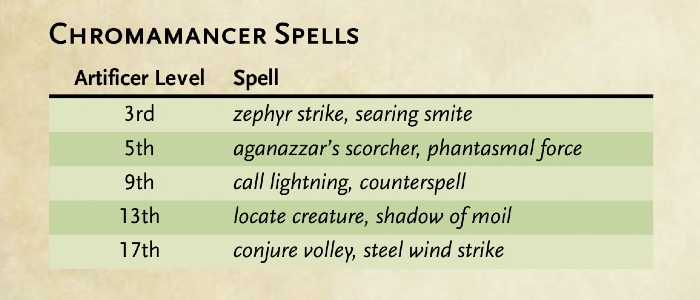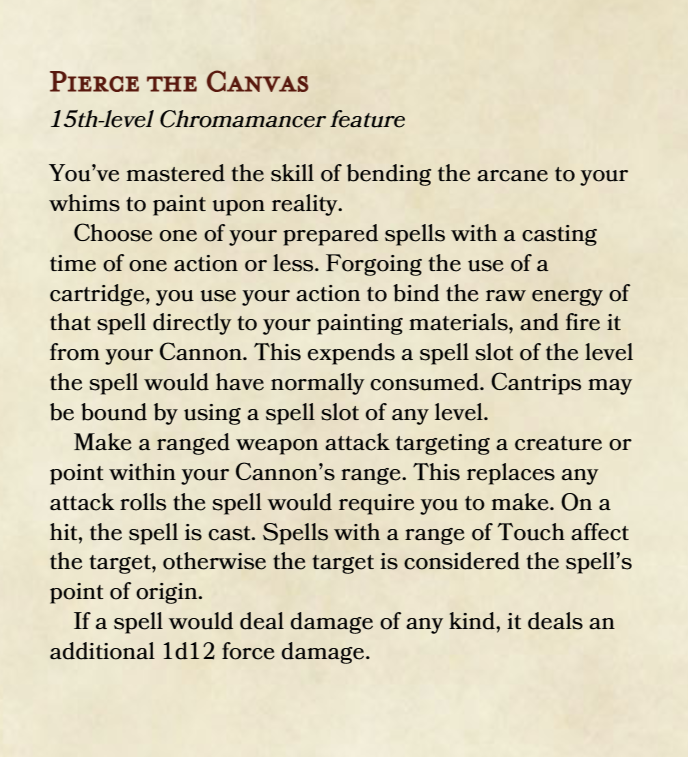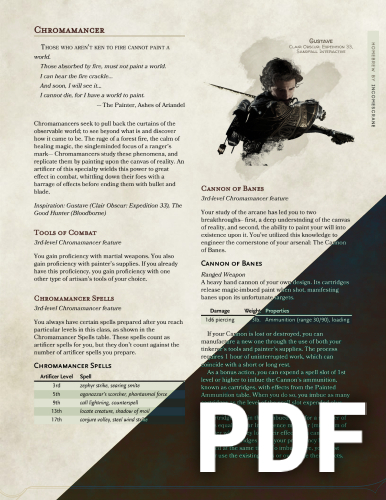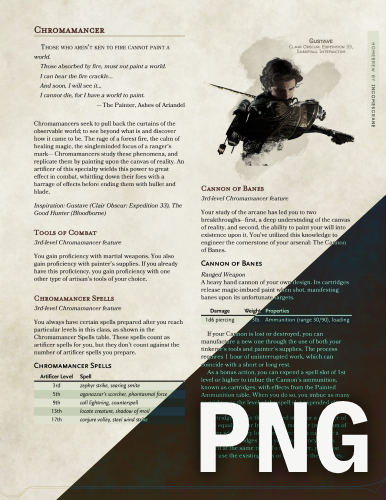_
(_)
_ _ __ ___ ___ _ __ ___ ___ ___ ___ _ __ __ _ _ __ ___
| | '_ \ / __/ _ \| '_ ` _ \ / _ \/ __|/ __| '__/ _` | '_ \ / _ \
| | | | | (_| (_) | | | | | | __/\__ \ (__| | | (_| | | | | __/
|_|_| |_|\___\___/|_| |_| |_|\___||___/\___|_| \__,_|_| |_|\___|
_
(_)
_ _ __ ___ ___ _ __ ___ ___ ___ ___ _ __ __ _ _ __ ___
| | '_ \ / __/ _ \| '_ ` _ \ / _ \/ __|/ __| '__/ _` | '_ \ / _ \
| | | | | (_| (_) | | | | | | __/\__ \ (__| | | (_| | | | | __/
|_|_| |_|\___\___/|_| |_| |_|\___||___/\___|_| \__,_|_| |_|\___|
Chromamancer
-
*** * ***
Based on Clair Obscur: Expedition 33's Gustave with some Bloodborne influence mixed in, Chromamancer is an artificer subclass all about painting, dual wielding, and getting to parry with a gun.
05 aug 2025
Return to home. -
*** * ***

The goal was, on the surface, pretty simple: translate the gameplay of Clair Obscur's Gustave into 5th Edition Dungeons & Dragons. The idea popped into my head earlier this year, when my mind was occupied mostly by prep for a campaign I was GM-ing at the time, and complete and utter fascination with Expedition 33.
While a full-fledged Expeditioner class with subclasses for Gustave and the rest of the cast was an option, it went beyond the scope of what I wanted to achieve here. Instead I searched for an existing class to fit this new subclass onto, and landed on artificer. It enabled the fantasy— Gustave is an engineer and inventor in CO:E33— and it came with firearm proficiency built in.
While a full-fledged Expeditioner class with subclasses for Gustave and the rest of the cast was an option, it went beyond the scope of what I wanted to achieve here. Instead I searched for an existing class to fit this new subclass onto, and landed on artificer. It enabled the fantasy— Gustave is an engineer and inventor in CO:E33— and it came with firearm proficiency built in.
If you want to just see the finished product, the subclass is available to download below as either a PDF or image. Made with Homebrewery.
The goals for what I wanted to translate over were:
-
Enable status effect inflicting gameplay
In Clair Obscur, my favorite build for Gustave (and later Verso) was one where his main focus was on support. With the use of certain Pictos you can use your free shots to apply Mark and Burn, both of which enable other party members with conditional skills (do X when the enemy is Marked/Burned/etc.).
-
Gun-melee dual wielding
In general, D&D subclasses do not restrict the types of weapons players can use, but they do incentivize particular options, and I wanted to do the same with this subclass. Something to enable the dual wielding of a firearm alongside a melee weapon, like both Gustave and the Good Hunter.
-
Parrying with a gun
Speaking of Bloodborne's Good Hunter, the final idea I wanted to incorporate I wanted to include was that game's parrying/stagger mechanic.
These were my main design goals, but before I could go in and try to turn them to a subclass, I needed to research the design of existing artificer subclasses. So I set out for sourcebooks and forums to do—
-
*** * ***
A LOT OF RESEARCH
Some time ago while designing a fighter subclass I came across this reddit post which had some very detailed breakdowns of how subclasses for all available classes were designed. Unfortunately, the post was missing Artificer (which was only introduced in 2020's Tasha's Cauldron of Everything) so while it was an invaluable resource for previous homebrews of mine, it wasn't something I could lean on this time around.
Looking at the four official subclasses— Alchemist, Artillerist, Battle Smith, and Armorer— I found that they're vastly different from each other in style and function. They are similar only in that they are defined by a specific tool proficiency which enables the subclass's fantasy, and that they get their defining gameplay element immediately at 3rd level, which then gets expanded upon as they progress. This feature is unique in a way that distinguishes them from the other subclasses, and usually gives them something to do with their Bonus Action.
The 5th level feature was more static— either the subclass was given a way to increase the damage/healing of their spells, or they were given Extra Attack. 9th level either expanded upon the subclass's core feature or gave them new minor perks (such as being able to cast certain spells without consuming slots), and sometimes came with another small damage bonus. 15th level rounded out the subclass by giving it more functionality, and a final boost to damage or healing output as they get ready to head into the 4th tier of play.
Finally, with the exception of Armorer allowing players to take on more Artificer Infusions, none of the subclasses interacted with or expanded upon the main class features. Artificer was, as I understood it, a framework you could customize to your liking. Considering the base class is all about being inventive, it makes sense.
The 5th level feature was more static— either the subclass was given a way to increase the damage/healing of their spells, or they were given Extra Attack. 9th level either expanded upon the subclass's core feature or gave them new minor perks (such as being able to cast certain spells without consuming slots), and sometimes came with another small damage bonus. 15th level rounded out the subclass by giving it more functionality, and a final boost to damage or healing output as they get ready to head into the 4th tier of play.
Finally, with the exception of Armorer allowing players to take on more Artificer Infusions, none of the subclasses interacted with or expanded upon the main class features. Artificer was, as I understood it, a framework you could customize to your liking. Considering the base class is all about being inventive, it makes sense.
At this point, I had added another set of rules to adhere to alongside the design pillars I outlined before:
-
Introduce a core mechanic at 3rd level
This should play into the fantasy of Chromamancer and also give the player something to do with their Bonus Action.
- No need to link the features to those from the base class
- And finally, a pesky new problem:
-
Don't step on the toes of Artillerist
Artillerist, you see, features the ability to build independent cannons or turrets of various types. With my focus on gunplay being a major component of the new subclass, I needed to make sure I didn't replicate what made Artillerist unique for fear of giving Chromamancer no reason to exist.
-
*** * ***
CHROMAMANCER, VERSION 1.0
With this set of restrictions, I made the first version of Chromamancer:
3rd level - Tool Proficiency
Tool proficiency was an easy choice of Painter's Supplies, due to the connection with Clair Obscur and the Expeditioners' chroma-based magic. Knowing I wanted the subclass to get access to swords, I also included a Martial Weapon proficiency in the feature. Armorer gave the player heavy armor proficiency alongside their tools, so there was precedence for the subclasses to give out more than one.3rd level - Expanded Spell List
The expanded spell list was easy and pretty to build. I focused on spells that replicated weapons or skills from CO: E33 or Bloodborne, or that just fit the theme of painting. My favorite picks were Call Lightning to parallel Gustave's full Overcharge ability, and Aganazzar's Scorcher as a parallel to Bloodborne's Flamesprayer.
3rd level - Cannon of Banes
The last thing left to introduce at 3rd level was the main gameplay feature that would distinguish Chromamancer. I wanted to introduce both the dual wielding and the status inflicting elements here, but wrapping them up in the same feature proved to be a challenge. I ended up splitting them into two different features and decided to revisit them after I had done playtesting on the subclass's first iteration.When searching for a way to coalesce the idea of gunplay and painting, I landed on the word "Cartridge", because it was something that could contain ink, or another word for ammunition. A Chromamancer could have paint-ladden Cartridges that inflicted some status effect when they hit a target. I imagined this gun as a sort of hand cannon, and dubbed the whole feature the Cannon of Banes:
"The cornerstone of your arsenal is the altered firearm ever present at your hip, and the arcane Cartridges it fires, infused with various banes. You've developed a process to modify any one-handed firearm so that it is capable of taking these Cartridges alongside its regaular ammunition."
To make the description of the Cannon and its functionalities fully clear, there were more questions in need of answers:
- How would the Cannon of Banes be acquired?
- A Chromamancer could modify any one-handed firearm to be their Cannon of Banes. This paralleled other subclasses like Armorer and Eldritch Knight (who can convert any armor into Arcane Armor, or bond to any weapon, respectively). This modification would not remove the firearm's ability to act as a ranged weapon.
- What Banes could it apply?
-
The initial list of Banes I came up with was:
Cartridge Effect Signal This Cartridge coats whatever it hits with bright, shimmering paint. The first attack roll made against the target before the end of your next turn has advantage. Marking This Cartridge smears charcoal onto its target. The first weapon attack made against the target before the end of your next turn can roll one additional weapon damage die. Distracting This Cartridge explodes to splatter the target with an incredible amount of paint. Until the start of your next turn, the target has a 1d4 penalty to all attack rolls and saving throws. Siphoning This Cartridge draws an ephemeral line between you and its target. The next melee weapon attack you make against the target, you regain hit points equal to half the amount of damage dealt. If the target dies to the attack, you regain hit points equal to the damage. - What should Banes cost?
-
Since the effects I'd lined out were similar to ones granted by certain spells, I chose spell slots as the limiting resource.
However, I did want to make them a bit more efficient than regular spellcasting— artificer is a half-caster and spending their precious few higher level slots on effects that are weak by comparison would feel wasteful.
To do this I made it so a single spell slots would imbue as many Cartridges as its level + 1.
3rd level - Occupied Hands
Next it was time to focus on the feature that would enable dual wielding.
While the basic rules of 5e allow any character to fight with two weapons, it comes with the restrictions that both of those weapons must have the Light property, and keeps damage in check by not allowing your ability modifier to be added the damage of the second attack.
This means two weapon fighting quickly falls behind in damage output unless it is supported by fighting styles like Two-Weapon Fighting (only accessible to fighter, ranger, and College of Swords bard), and/or the Dual Wielder feat, (which only boosts melee dual wielding, not firearms like we need). The details and calculations behind the effectivity of dual wielding builds is beyond the scope of this analysis, but there is plenty of discussion on how they usually fall short available online for those curious.
While the basic rules of 5e allow any character to fight with two weapons, it comes with the restrictions that both of those weapons must have the Light property, and keeps damage in check by not allowing your ability modifier to be added the damage of the second attack.
This means two weapon fighting quickly falls behind in damage output unless it is supported by fighting styles like Two-Weapon Fighting (only accessible to fighter, ranger, and College of Swords bard), and/or the Dual Wielder feat, (which only boosts melee dual wielding, not firearms like we need). The details and calculations behind the effectivity of dual wielding builds is beyond the scope of this analysis, but there is plenty of discussion on how they usually fall short available online for those curious.
To give Chromamancer some breathing room to invest in other things, I combined elements of the fighting style and the feat together and gave the subclass the following benefits intrinsically:
I decided leave out the AC increase Dual Wielder would normally grant because artificers can already increase their AC with the use of the Enhanced Defense infusion, and I didn't want to give the subclass something so powerful for free.
Additionally, the restriction of only getting these benefits while you are using the Cannon would strike a happy medium between allowing a choice of any melee weapon to pair with it, while disincentivizing two-handed weapons (which would go against the fantasy I was aiming for).
- Adept at two-weapon fighting, you have the following benefits while you are wielding your Cannon of Banes:
- You can also use a one-handed melee weapon even if it does not have the light property.
- You can add your ability modifier to the damage of all weapon attacks you make.
Additionally, the restriction of only getting these benefits while you are using the Cannon would strike a happy medium between allowing a choice of any melee weapon to pair with it, while disincentivizing two-handed weapons (which would go against the fantasy I was aiming for).
5th level - Quicker Hands
Since Chromamancer was shaping up to be more of a combat-focused subclass as opposed to a spellcaster, I followed convention and gave it Extra Attack.I figured this was also a good place to introduce the parry mechanic into the subclass's arsenal. It was a perfect fit for a reaction, allowing a Chromamancer to impose disadvantage on attacks made against them. And since I believe it's better to start out overpowered and slowly nerf things to be more balanced(1), I added a final boon inspired by Bloodborne— just like how a gun parry will let you follow up with a visceral attack, if a Chromamancer's parry could make an attack miss, their first melee weapon attack against that enemy could crit on a roll of a 19 or 20.
(1) This is what 7+ years of Destiny 2 will do to a person's game design sensibilities.
9th level - Enhanced Cartridges
9th level was the time to expand the Cannon of Bane's options.| Cartridge | Effect |
|---|---|
| Incendiary | The Cartridge sparks a fire upon impact. The target takes 3d8 fire damage and must make a Constitution saving throw. If it fails, it takes an additional 1d8 fire damage for every weapon attack made against it until the start of its next turn. |
| Elemental Regression | This Cartridge explodes into smoke of a peculiar hue. Choose one element from acid, cold, fire, lightning, necrotic, radiant, or thunder. The target's resistance to that element is nullfied until the start of your next turn. If they are immune to the chosen element, they are unaffected. |
I introduced the Burn effect here via the Incendiary Cartridge. In CO: E33, burn is a decaying damage-over-time effect, which is hard to implement in D&D. DOT mechanics run the risk of slowing the game down with calculations, and require extra attention from the players or DM to keep them in mind. That's why when adapting it I gave the Cartridge an immediate effect first, with a chance to linger but only for a short amount of time.
I paired this with another Cartridge which allows you a nullify a single resistance an enemy might have for one round at most— this is a powerful support option for the rest of your team, or can be used to nullify a target's resistance to fire to enable your own Incendiary shots. Did you know fire is the most common resistance among enemies as CR goes up?
The hope is the player can come to this conclusion by seeing the two options next to each other, but I could be looking too deep into it 😅.
I added one final benefit at this point: when you make an attack roll to fire an imbued Cartridge, you get to add your Intelligence modifier to the roll. Unlikely to be more than a +5 bonus at maximum, I wanted to give the subclass a way to avoid the frustration of using your signature ability and having it be ineffective.
I paired this with another Cartridge which allows you a nullify a single resistance an enemy might have for one round at most— this is a powerful support option for the rest of your team, or can be used to nullify a target's resistance to fire to enable your own Incendiary shots. Did you know fire is the most common resistance among enemies as CR goes up?
The hope is the player can come to this conclusion by seeing the two options next to each other, but I could be looking too deep into it 😅.
I added one final benefit at this point: when you make an attack roll to fire an imbued Cartridge, you get to add your Intelligence modifier to the roll. Unlikely to be more than a +5 bonus at maximum, I wanted to give the subclass a way to avoid the frustration of using your signature ability and having it be ineffective.
15th level - Pierce the Canvas
For the final feature, it was time to give the Cannon one last boost to utility and damage.
I gave the Chromamancer the ability to fire off one of their prepared spells from their Cannon, allowing a short-range spell to be cast from a much greater distance. The hope was that the ability to use spells such as Revivify without having to expend movement and expose yourself to opportunity attacks or difficult terrain would be significant.
In the wording I was careful to include that this forgoes the use of a Cartridge— this means a spell "cast" in this way would not get the +INT bonus to the attack roll we just mentioned above. This is to prevent a player from casting all spells like this just to abuse that bonus.
In the wording I was careful to include that this forgoes the use of a Cartridge— this means a spell "cast" in this way would not get the +INT bonus to the attack roll we just mentioned above. This is to prevent a player from casting all spells like this just to abuse that bonus.

-
*** * ***
PLAYTESTING, AND SOME PROBLEMS
With these set in stone, I set out to do some playtesting, and immediately stumbled into a problem.My bonus action was very, very crowded.
On any given bonus action I could:
- Make a melee weapon attack
- Make a ranged weapon attack with the Cannon (deals damage)
- Make a ranged weapon attack to fire a Cartridge (deals no damage)
- Use any other abiltity granted by a multiclass, feat, item, etc.
Another point that came up was:
Imbuing had no limits.
A player could potentially imbue as many Cartridges as their spell slots allowed before a long rest, and wake up with their slots refreshed and a huge supply of ammunition ready.
Finally, I discovered that:
Limiting parrying to reactions was not enough.
A Chromamancer could impose disadvantage on the first attack made against them every round of combat, every single combat encounter in a day. A DM could then resort to targeting them multiple times per round to try and land a hit, which turned the Chromamancer into a sort of aggro magnet, drawing damage away from their party. This was not within the subclass's fantasy, and I didn't want it to be eqipped to handle that kind of pressure.
With all this in place, I retooled some abilities and moved on to:
-
*** * ***
CHROMAMANCER, VERSION 2.0
Cannon of Banes, revised
One the second pass, I looked at the Cannon and began to trim the fat. The Cannon could deal whatever damage the firearm it was made from dealt, or no damage at all when firing a Cartridge. The two different values felt confusing, so I gave it a set damage value of 1d6 piercing and and cleaned up the language describing it as a dual purpose weapon.It would now fire only Cartridges, which could either be imbued or not, and they'd deal the same damage regardless. After all, the D&D equivalent of a paintball is bound to hurt even if it doesn't have magic attached to it.
This also had the benefit of putting the fantasy of subclass's core feature in line with the others— the Cannon was now an item fully of the artificer's own creation instead of something they found and modified.
Next, I removed the restriction of only being able to fire imbued Cartridges on a bonus action and moved the Imbue ability in its place. Now there was a strong delineation between anything requiring an attack roll being an option during both actions AND bonus actions, and the subclass-specific Imbuing being limited to the bonus action.
This also opened up a strategical choice: by allowing imbued Cartridges to be fired as part of an action a Chromamancer could potentially shoot out multiple on their turn, forgoing most of their damage output to devote themselves to supporting their party. Combos like Regression into Incendiary into Signal or Marking could be put out during a single turn— something I was excited to play around with.
Cap those Cartridges
To deal with the potential of infinite Cartridges, I add the following restrictions:- You can only have a number of Cartridges equal to your proficiency bonus imbued at any given time.
- Cartidges lose their effects after a number of hours equal to your INT modifier.
(2) Unless you're playing an Elf.
Limited parries
I ended up restricting the amount of times you can use your reaction to Parry to a number of times equal to half the player's proficiency bonus (rounded up) per long rest. Since most parties only get into one combat encounter per LR this feels like a good compromise, but will require further testing to be sure of.-
*** * ***
CHROMAMANCER, VERSION 2.1
With those pain points sorted, I decided to take another pass at the text, mostly to clean up any ambiguities or shorten bloated descriptions. This version of the text is the lastest, available below.To round the homebrew out I also included some Artificer Infusions. Infusions are designed be useable by any subclass so I couldn't include things which would only benefit a Chromamancer.
| Infusion | Description |
|---|---|
| When One Falls |
Item: A pair of boots (requires attunement)
While wearing these boots, you are instilled with a sense of urgency. Once per turn, when one of your allies falls to 0 hit points, you can use your reaction to immediately move a distance up to your regular movement speed. |
| Granted Eyes |
Item: A pair of glasses or goggles (requires attunement) While wearing this item, you have advantage on all Wisdom (Insight) and Wisdom (Perception) checks. |
I also finally gave the subclass some flavor text. For reasons that will make no sense unless you're past the first boss of Act 2 in Clair Obscur, and barely any unless you've played both the endings, I picked dialogue from the Painting Girl from Dark Souls 3's Ashes of Ariandel DLC.
"Those who aren't ken to fire cannot paint a world.
Those absorbed by fire, must not paint a world.
I can hear the fire crackle…
And soon, I will see it…
I cannot die, for I have a world to paint."
I liked how it resonated with themes of the responsibility that comes with creating arcane art that Clair Obscur touches upon (and that I wish it delved more into), while also bridging the gap between it and Bloodborne with its connection to both painting and Fromsoftware. Above all, it felt like it clearly communicated the fantasy I wanted Chromamancer to embody:
Those absorbed by fire, must not paint a world.
I can hear the fire crackle…
And soon, I will see it…
I cannot die, for I have a world to paint."
An arcane inventor deeply knowledgable about the canvas
of reality, and how to paint their will to life upon it.
-
*** * ***
A Life to Paint Playtest
With that, I was satisfied with this iteration of Chromamancer and I feel good about putting it out there for others to try it out. I anticipate it will need more tweaking in the future, with underpowered or gamebreaking elements that can only be revealed through more playtesting than my little group of D&D friends can muster. If you try it out and have questions or comments, reach out! For now, I'm satisfied with this little foray into homebrew and the ability to give one of my favorite characters in recent memory a bit more life outside of his own game.
Until the next homebrew o7
Until the next homebrew o7

